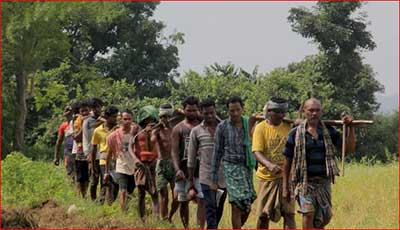Date: 02/02/2023
Relevance: GS-2: Government policies and interventions for development in various sectors
Key Phrases: Welfare State, unorganised workers ‘eShram portal’, private-public partnerships, Economic Survey 2022-23, female labour force participation rate (FLFPR), UN-SDG target, Aspirational Districts.
Context:
- The Directive Principles enshrined in the Constitution guide India to be a “welfare state.”
- In keeping with this spirit, the Government is committed to the welfare and equitable development of the country’s citizens.
What is a Welfare State?
- A welfare state is a form of government in which the state (or a well-established network of social institutions) protects and promotes the economic and social well-being of its citizens, based upon the principles of equal opportunity, equitable distribution of wealth, and public responsibility for citizens unable to avail themselves of the minimal provisions for a good life.
- There is substantial variability in the form and trajectory of the welfare state across countries and regions.
- All welfare states entail some degree of private-public partnerships wherein the administration and delivery of at least some welfare programmes occur through private entities.
- Welfare state services are also provided at varying territorial levels of government.
- In particular, Article 38 requires the state “…to secure a social order for the promotion of the welfare of the people” and “…. strive to minimise the inequalities in income, and endeavour to eliminate inequalities in status, facilities, and opportunities, not only amongst individuals but also amongst groups of people residing in different areas or engaged in different vocations.”
How Government is Ensuring a Welfare State?
- The Government is making all efforts to meet the demands of society, as economic growth without shared prosperity and well-being is devoid of meaning.
- Social Infrastructure and Employment:
- Big tent in the Economic Survey 2022-23 presents a review of the progress of governmental efforts.
- It is sprinkled with data analysis and box write-ups on various aspects of social sector initiatives of the Government and their outcomes.
- Employment generation, coupled with improving the quality of jobs, is a priority.
- Following this path, the organised sector job market conditions measured by EPFO and NPS subscriptions indicate a YoY increase, pointing towards improved formalisation.
- The urban labour market indicators have improved beyond pre-Covid levels, with the unemployment rate falling and the labour force participation rate increasing.
- The female labour force participation rate (FLFPR) has increased substantially, driven by the rural FLFPR, which has risen from 18 per cent in 2017-18 to 28 per cent in 2020-21.
- UNDP’s Acknowledgement :
- The UNDP has acknowledged India as being one of the few countries on its way to achieving the UN-SDG target of halving poverty by 2030.
- 117 Aspirational Districts :
- The special focus on 117 Aspirational Districts across the country has resulted in steady improvements across several parameters, such as financial inclusion, health and nutrition, maternal and infant mortality rates etc., in such identified districts.
- Social Protection Schemes :
- A bouquet of social protection schemes, customised for different sections of the population such as the elderly and unorganised workers, have been prioritised, ensuring a shield of dignity for every member of society.
What Structural Reforms been taken?
- Accurate Land Records for Rural Planning:
- The emphasis on creating accurate land records for rural planning and reducing property-related disputes through SVAMITVA is a structural reform in rural land management and individual economic empowerment.
- Ayushman Bharat Scheme:
- The path-breaking Ayushman Bharat scheme, with over 22 crore beneficiaries, is being further tech-enabled through digital health ID ‘ABHA’ and telemedicine through eSanjeevani.
- National Education Policy:
- Within the progressive framework of the National Education Policy, improving schools’ basic facilities and the pupil-teacher ratio is expected to yield medium-term human capital dividends.
- The expanding higher education and skilling infrastructure is improving the quality of education and employability of the youth.
- There are now 23 IITs, 20 IIMs, nearly 650 medical colleges, 25 IIITs, over 1113 universities and enhanced skilling initiatives.
- These breakthroughs have materialised due to smart policymaking meeting process re-engineering, technology adoption and effective implementation.
- Citizen-State Relationship:
- The ecosystem of Jan Dhan Yojana-Aadhaar-Mobile trinity, common service centres, geospatial technology, and real-time monitoring of outcomes have infused speed and efficiency into the citizen-state relationship.
- Role of Technology:
- Technology is being harnessed to help deliver various Government schemes to the targeted citizens.
- Aadhaar has been instrumental in enabling targeted delivery of Direct Benefit Transfers (DBT) through 318 Central Schemes and over 720 State DBT schemes, seamless portability of ration cards across States through ‘One Nation One Ration Card’ and a national database of unorganised workers ‘eShram portal’.
- National Career Service:
- The ‘National Career Service’ project is a one-stop solution providing various employment and career-related services.
Conclusion:
- Welfare for all, in the spirit of a “welfare state” is although, tough but it is being realised steadily and surely.
Source: The Hindu BL
Mains Question:
Q. The Directive Principles enshrined in the Constitution guide India to be a “welfare state”. In keeping with this spirit, how far government has achieved welfare and equitable development of the country’s citizens?(250 Words).







